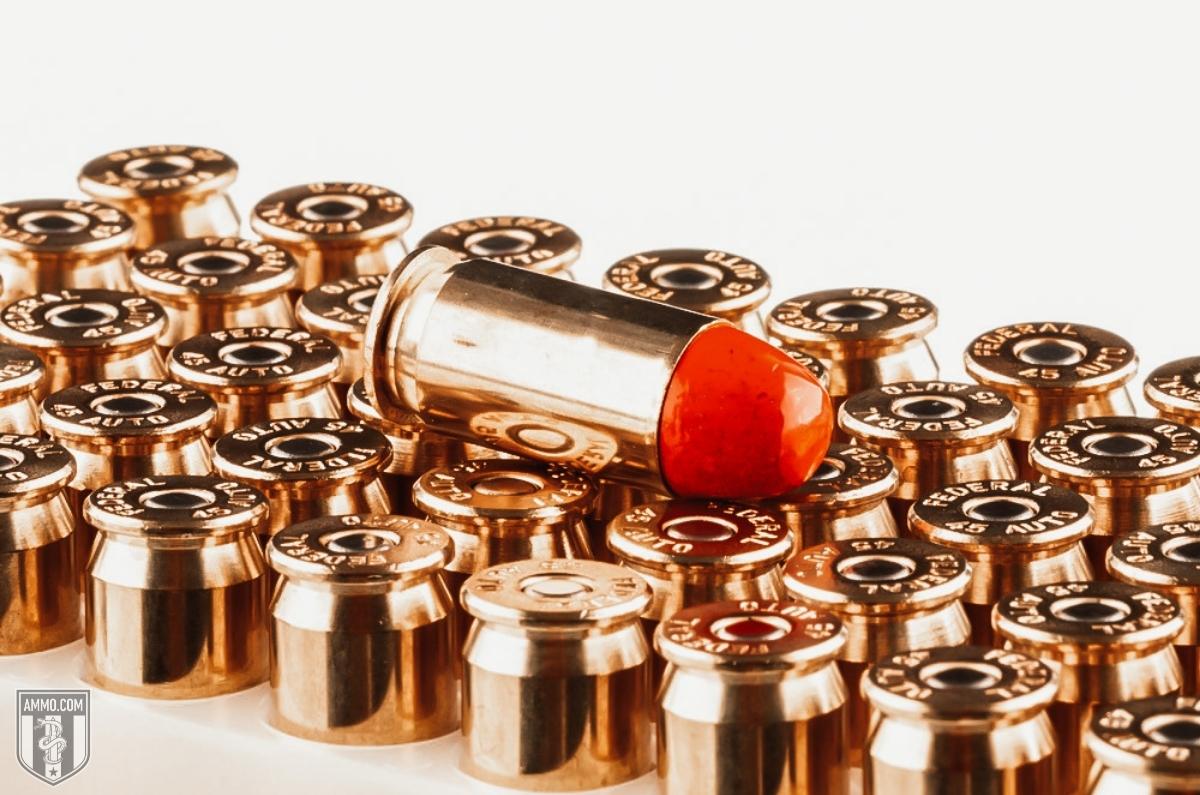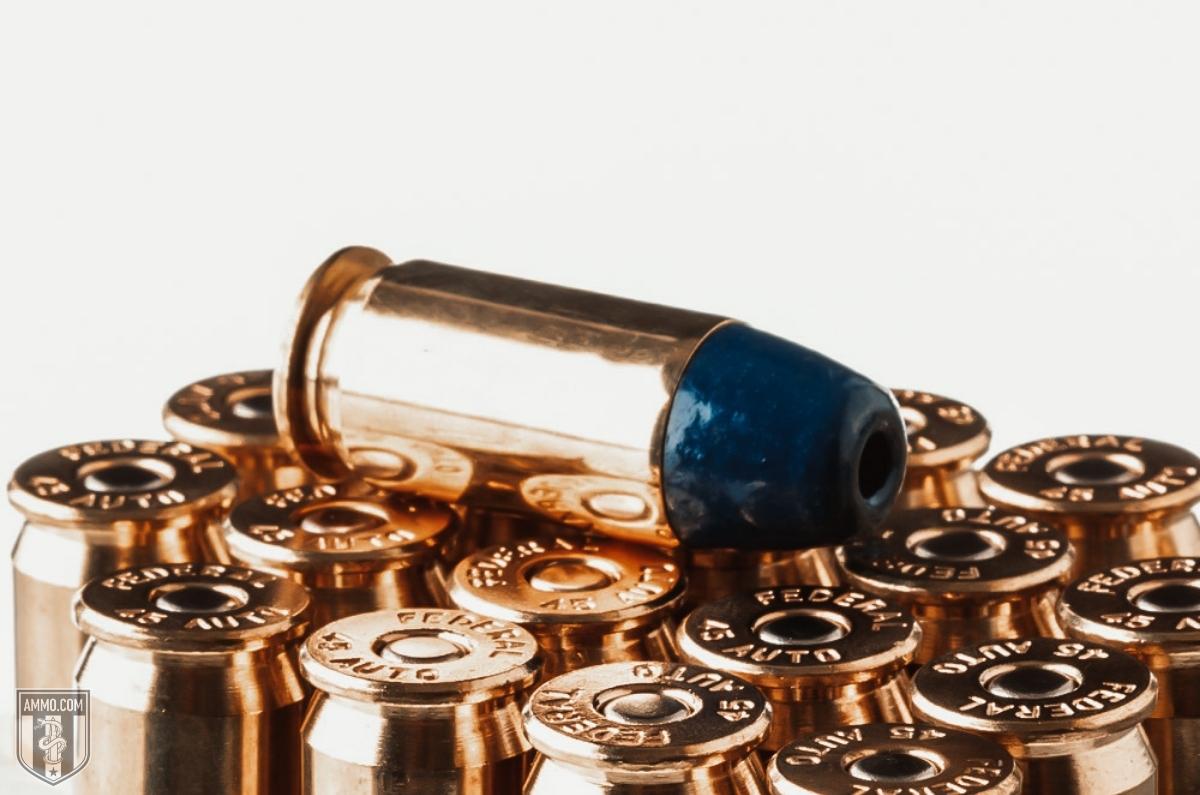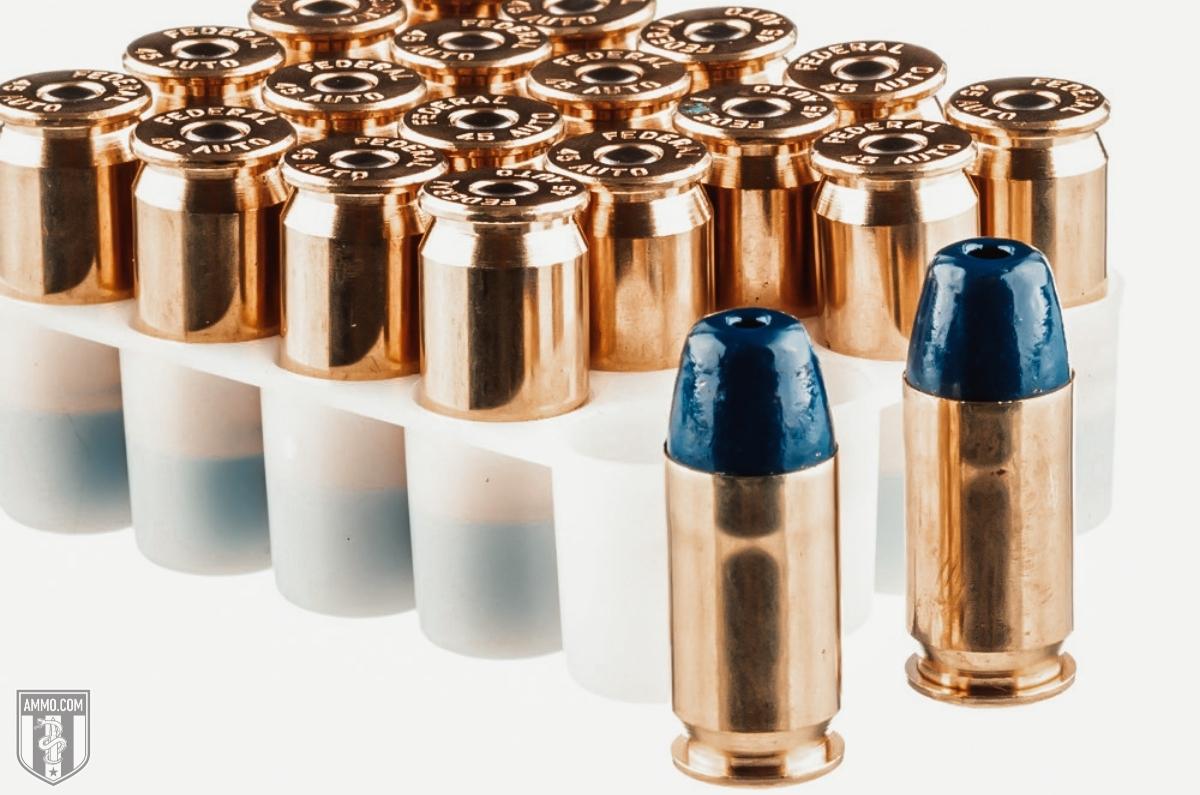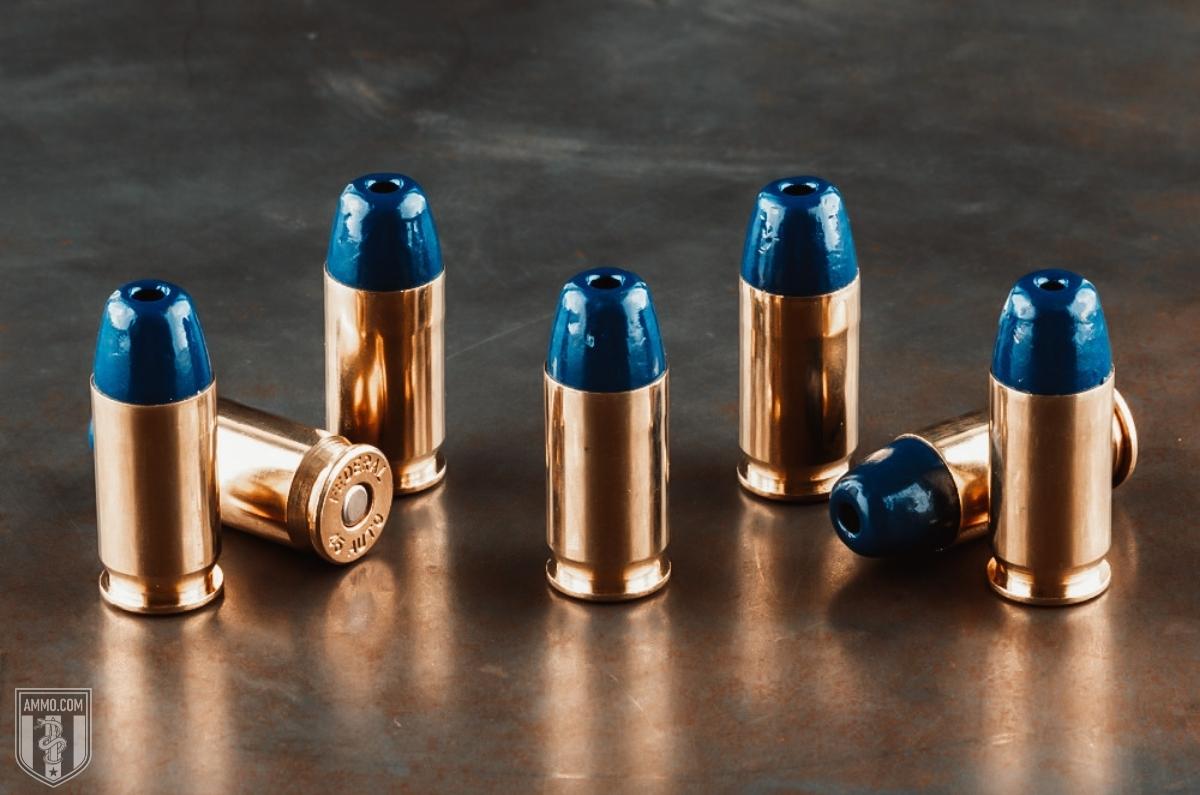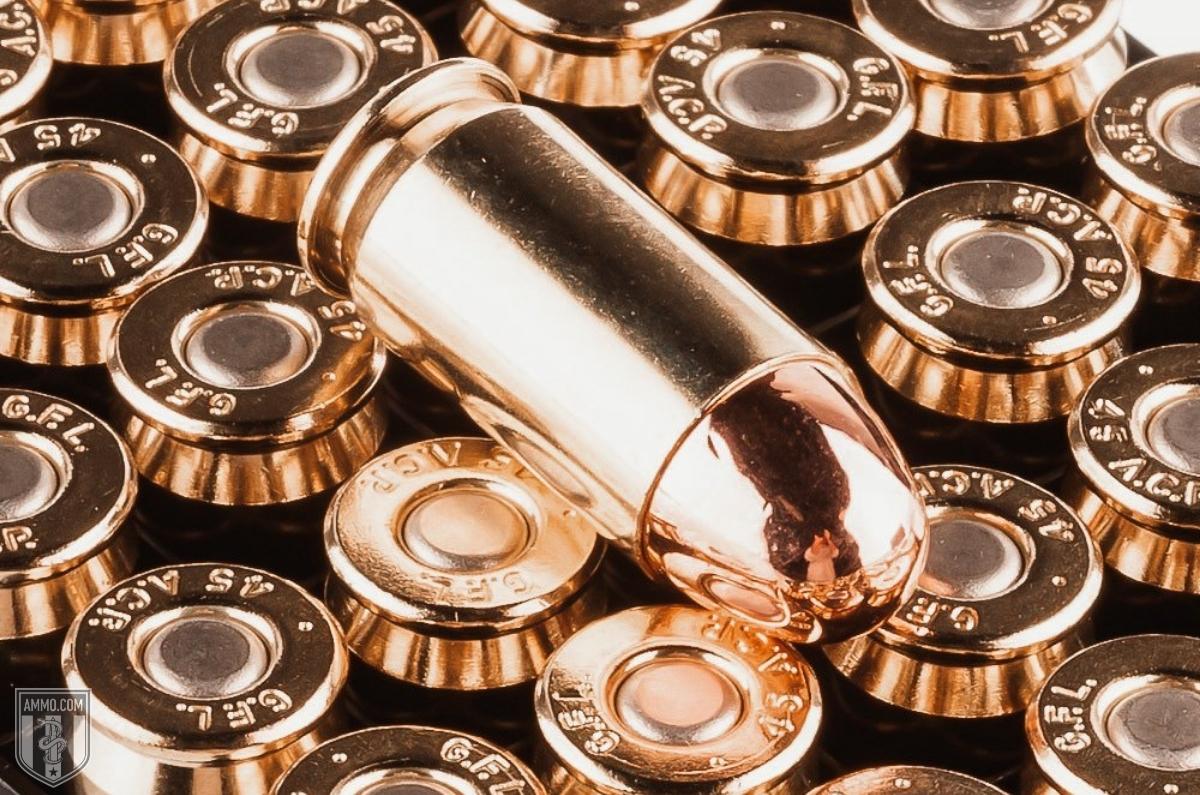45 ACP vs 45 Auto: Are They the Same or Different?
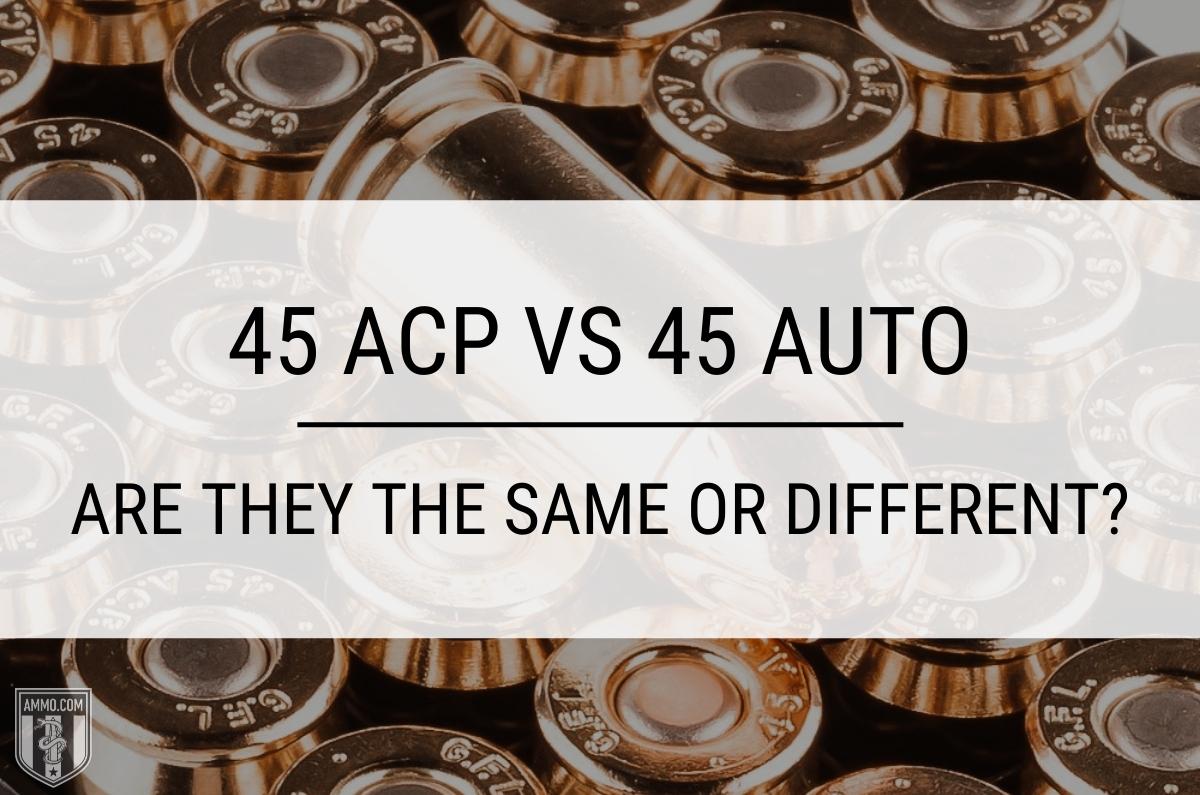 Handgun cartridge naming is an aspect of firearm ownership that can be confusing to new shooters at first – and if you decide to get yourself a full-size Sig Sauer 1911 or Glock 21, you might note on the barrel that it says, “45 Auto.” Excited to get some ammo for your new sidearm, you peruse the gun store shelves and are dismayed to only find boxes labeled, “45 ACP.”
Handgun cartridge naming is an aspect of firearm ownership that can be confusing to new shooters at first – and if you decide to get yourself a full-size Sig Sauer 1911 or Glock 21, you might note on the barrel that it says, “45 Auto.” Excited to get some ammo for your new sidearm, you peruse the gun store shelves and are dismayed to only find boxes labeled, “45 ACP.”
This leads many new shooters to wonder, “Is 45 Auto the same as 45 ACP?”
Although they have different names, the 45 Auto and 45 ACP cartridge are the same.
So why is 45 Auto and 45 ACP labeled differently? We’ll get to that! In this article we’ll explain the differences in cartridge naming for the 45 ACP/45 Auto as well as explore some different varieties of 45 caliber handgun rounds.
45ACP vs 45 Auto: What is the difference between 45 Auto and 45 ACP?
The 45 ACP and 45 Auto are the same cartridge, there is no difference between them except for their name.
What Does ACP Stand For in 45 ACP?
The “ACP” in 45 ACP stands for Automatic Colt Pistol.
The 45 ACP was developed for the U.S. Army by the renowned American firearms inventor, John Moses Browning, in 1904. The U.S Army needed a new pistol round that had more stopping power as they were unsatisfied with the performance of their .38 Long Colt revolvers.
At that time, Browning was working for Colt to develop a new semi-automatic handgun for the U.S. military, and they chambered the new .45 caliber cartridge in what later was named the Colt Model 1911. The new pistol cartridge was dubbed the “.45 Automatic Colt Pistol”, or 45 ACP for short.
What is ACP Ammo?
The 45 ACP is a rimless centerfire handgun cartridge that is designed for use in a semi-automatic pistol. It fires a 45-caliber bullet (0.451” bullet diameter) between 185 and 230 grains. The 45 ACP cartridge has been popular with the U.S. military, law enforcement, and civilian concealed carry permit holders since its release.
John Moses Browning’s initial design for the 45 ACP cartridge fired a 200-grain bullet with a muzzle velocity of 900 fps. However, after some modifications by the Frankford Arsenal, Union Metallic Cartridge, and Winchester, the finalized version was adorned with a 230-grain full metal jacket (FMJ) with a muzzle velocity of 850 fps.
For the most latest ammunition, visit our Winchester .45 ACP ammo page!
After adoption by the U.S. Army in 1910, the Colt 1911 and the 45 ACP served in all branches of the U.S. military for the next 70+ years as the standard issue sidearm and ammo. It carried us through World War I and II, the Korean War, and Vietnam. It was not until the 1980s that the military decided to update their standard issue sidearm and opted to move towards the Beretta M9 and the 9mm Luger cartridge as it had less recoil and higher magazine capacity than the stalwart 45 ACP.
Since its inception, the 45 ACP was known by that name, but in 1926 everything changed. This was the year that the Sporting Arms and Ammunition Manufacturers’ Institute (SAAMI) was founded, and their goal was to standardize the shooting industry. This is a good thing, as it means that ammo purchased from Remington must be within the same set of parameters as the ammo produced by Hornady, Winchester, Federal, or Sig Sauer.
There’s no doubt that the founding of SAAMI was a good thing for the shooting industry. But one thing that was not so helpful was their refusal to have any type of trademarked name in their database to avoid any legal issues. As the 45 Automatic Colt Pistol was trademarked, SAAMI refused it under that name. Therefore, an identical cartridge with the exact same specs as 45 ACP was submitted under the name of “45 Automatic” or 45 Auto for short.
This is how the 45 ACP came to have two names for the same cartridge. And the 45 ACP/45 Auto is not the only pistol round to multiple names. The same thing happened with the 9mm Parabellum, the most prolific handgun round in the world and George Luger’s pride and joy. As 9mm Parabellum was trademarked, the design submitted to SAAMI was dubbed the 9mm Luger. And to make matters worse, once the 9mm Luger was accepted as a NATO cartridge, it became known as the 9x19mm NATO.
To complicate things further, there are cartridges that share the same caliber but are completely dissimilar from each other. Take for example the 357 SIG and 357 Magnum, 9mm Luger and 9mm Makarov, or even the 38 Super and 38 Special. All the caliber pairs listed above have the same caliber name but completely different cartridge specs and are not related or interchangeable.
Therefore it is so important to understand how cartridges are named and to know what your semi-auto handgun or revolvers are chambered in.
What are Some Different 45 Caliber Handgun Cartridges?
Although many 45 ACP purists would like to believe that their round is the only true “45”, there are several other 45 caliber handgun cartridges available on the market. In the following sections you’ll find a sampling of different 45 caliber handgun cartridges that you might encounter on gun store shelves.
45 ACP +P
In any self-defense situation, you want to know that the ammo you are carrying has the stopping power to get the job done. Although stopping power is somewhat of a ubiquitous term with no empirical measurement system, many ammo manufacturers offer over-pressure rounds called “+p” (read: plus p).
Ammo designated as +p is rated for higher-than-normal maximum pressures as designated by SAAMI. Once +p rounds started to become more popular, it didn’t take long for a 45 ACP +p offering to hit the market.
Standard 45 ACP ammo is rated for a maximum chamber pressure of 21,000 psi, while 45 ACP +p is rated for 23,000 psi (about a 10% increase). This added pressure means higher velocity, more ft-lbs of muzzle energy, and deeper penetration.
Law enforcement and concealed carry permit holders often favor +p ammo for its improved ballistics and deeper penetration. Typical self-defense 45 ACP +p ammo carries a 185 grain jacketed hollow point bullet traveling at 1,200 fps.
If you own a modern 45 ACP pistol, it is most likely capable of firing +p ammo. However, if you are unsure, it is best to consult your owner’s manual or contact the manufacturer before firing +p ammo through your handgun. Using +p ammo in a sidearm that is not rated for it can have disastrous results, potentially damaging the firearm and the shooter.
.45 Colt
The .45 Colt is a rimmed revolver round that was designed by Colt for the U.S. Army in 1872. Also known as the 45 Long Colt, 45 LC, and .45 Colt Government, the 45 Long Colt served as the standard duty issue sidearm ammo for the army from 1873 until 1892.
The 45 Long Colt is most famous for being chambered in one of Colt’s most iconic revolvers of the age, the Colt Single Action Army. Also known as the “Peacemaker” it was the revolver of choice for many law enforcement officers of the time, including the legendary Wyatt Earp.
The 45 Long Colt and Single Action Army remained popular with the cavalry until the development of the 45 Smith & Wesson Schofield and subsequent adoption by the military in 1879 (more on that below).
Today, 45 Long Colt is still used today in Cowboy Action Shooting sports as well as in combination revolvers like the Taurus Judge and Smith & Wesson Governor.
45 Schofield
The .45 Smith & Wesson Schofield was developed in 1875 and is a rimmed revolver cartridge. It was designed in conjunction with the M1875 Schofield top break revolver and adopted by the U.S. Military shortly thereafter.
The new top break revolvers allowed cavalrymen to reload their revolvers in under 30 seconds, essentially half the time of the Colt Single Action Army. The 45 Schofield has less recoil than the 45 LC as it is a shorter cartridge and carries less powder. Lower recoil generally leads to increased accuracy and shootability, and by 1874 only 45 Schofield ammo was being distributed to military units.
Thankfully, the external dimensions of the 45 Schofield were the same as the 45 LC except for the cartridge length. This allowed 45 Schofield ammo to be safely fired from 45 LC revolvers, similar to how a 38 Special can be fired from a 357 Magnum.
After serving for nearly 20 years, the 45 Schofield was replaced by the 38 Long Colt in 1892. The Schofield is now considered an obsolete cartridge and is not in production except by custom ammo producers. However, the ballistics of the 45 Schofield were the foundation by which the 45 ACP was designed.
45 Auto Rim
In 1917, Colt released the M1917 revolver chambered in 45 ACP. As the 45 ACP was a rimless cartridge, the revolvers required the use of moon or half-moon clips to facilitate extraction and proper headspacing. These revolvers were issued to US troops in World War I to supplement the distribution of the M1911.
Although the half-moon clips were effective, they were easy to lose or misplace. If this were to happen, there are two potential issues. The first is failure to extract. Without a rim to hold onto, the extraction arm has nothing to grip and therefore rounds would have to be ejected from the cylinder one at a time with a field expedient object (think pencil). The second issue would be headspace. As the 45 ACP has no rim for headspace, it’s possible that a round could slip into the chamber and fail to fire.
To fix these issues, the Peters Cartridge Company developed the 45 Auto Rim in 1920. This new round was nothing more than a 45 ACP with a rim.
The new ammo allowed for the rounds to be fired and ejected without the use of a moon clip. 45 Auto Rim is compatible in revolvers chambered in 45 ACP, however it should not be used in a semi-automatic 45 ACP pistol.
45 GAP
The 45 Glock Automatic Pistol was developed in 2003 by CCI/Speer at the behest of Glock to duplicate the performance of the 45 ACP but in a smaller cartridge case so it could fit in smaller handguns.
Roughly equivalent to 45 ACP +p ammo, the 45 GAP has a smaller case volume but higher operating pressure to closely mimic 45 ACP ballistics. Although the 45 GAP has the same bullet diameter as its parent cartridge, it was designed to fire a lower bullet weight to allow for higher muzzle velocity.
A 45 GAP can fire a 200 grain Speer Gold Dot jacketed hollow point at 1050 fps with 490 ft-lbs of muzzle energy. The 45 GAP can fire the traditional 230 grain bullet, but it pushes the 45 GAP to its limits in terms of pressure.
Although the 45 GAP was technically successful at duplicating 45 ACP ballistics in a smaller package, the round simply did not take hold in the commercial or law enforcement market. Several small police departments still use the round, but most departments have move back to either 40 S&W or 9mm Luger for their duty ammo.
Glock is the only firearms manufacturer that currently has offerings in 45 GAP, but they only do small runs each year of their Glock 37, 38, and 39 sidearms.
As the 45 ACP and 45 GAP both headspace off the mouth of the case, it is NOT safe to fire 45 GAP in a 45 ACP pistol.
Final Shots: 45 ACP vs 45 Auto
There’s no denying that cartridge naming conventions can sometimes be confusing. No matter where you are in your firearms journey, understanding what round your handgun is chambered in is critical to a safe and enjoyable shooting experience.
Although they have different names, the 45 ACP and the 45 Auto are the exact same cartridge. The 45 ACP might be one of many entries into the lauded history of 45 caliber handgun cartridges, but it is truly “America’s Cartridge”.
Buying in bulk is always smart, make sure to check out our stock of bulk 45 ACP ammo.
And so long as there is breath in our lungs and the beating heart of patriotism in our chest, there will be 45 ACP/45 Auto ammo on gun store shelves ready to defend freedom should the moment arise.
Ammo Comparisons
- .308 vs 5.56
- 6.5 Creedmoor vs .308
- .300 Blackout vs .308
- .300 Win Mag vs .308
- .243 vs .308
- .308 vs .30-06
- 7mm-08 vs .308
- .270 vs .308
- 7.62x39 vs .308
- .223 vs .308
- .338 Lapua vs .308
- .380 ACP vs 9mm
- .223 vs 5.56
- .300 Blackout vs 5.56
- 9mm vs 45 ACP
- 9mm vs 40 S&W
- .357 SIG vs 9mm
- 10mm vs 9mm
- 9mm vs 9mm Luger
- .243 vs .270
- .300 Win Mag vs .30-06
- .270 vs .30-06
- .40 vs .45
- 38 Special vs 357
- 9mm vs 40 vs 45
- 5.56 vs 7.62x39
- 338 Lapua vs .30-06
- .30-30 vs .30-06
- 300 PRC vs 338 Lapua
- .30-06 vs 7mm
- 300 Win Mag vs 338 Lapua
- 300 PRC vs 300 Win Mag
- 300 WSM vs 300 Win Mag
- 338 Win Mag vs 338 Lapua
- 12 Gauge vs 20 Gauge
- 10mm vs 357 Mag
- .30-30 vs 7.62x39
- 224 Valkyrie vs 22-250
- 17 HMR vs 22 Mag
- 7.62x39 vs .300 Blackout
- 45 ACP vs 45 Auto
- 45-70 vs 30-30
- 300 Blackout vs 223
- 357 Magnum vs 9mm
- 350 Legend vs 300 Blackout
- 224 Valkyrie vs 223
- 45 ACP vs 38 Super
- 6.5 Grendel vs .308
- 17 HMR vs 22 LR
- 10 Gauge vs 12 Gauge
- 22-250 vs 223
- 45 Colt vs 45 ACP
- 350 Legend vs 30-30
- 5.7x28 vs 223
- 5.7 vs 9mm
- 5.56 vs 5.7
- 22 vs 9mm
- Buckshot vs Birdshot
- 450 Bushmaster vs 308
- 450 Bushmaster vs 223
- Buckshot vs Slug
- 6.5 Grendel vs 5.56 vs 223
- 6mm ARC vs 6.5 Grendel
- 44 vs 45
- 458 SOCOM vs 5.56
- 357 vs 44
- 32 ACP vs 380
- 300 Win Mag vs 338 Win Mag vs 338 Lapua Mag
- 450 Bushmaster vs 458 SOCOM vs 50 Beowulf
- 6mm Creedmoor vs 6.5 Creedmoor
- TMJ vs FMJ
- 44 Special Vs 44 Magnum
- 45 90 vs 45 70
- 6.8 Western vs 6.8 SPC
- 50 Beowulf vs 50 BMG
- 26 Nosler vs 6.5 PRC
- 28 Gauge vs 410
- 6.8 SPC vs 5.56
- 6.8 SPC vs 6.5 Grendel
- 6.8 Western vs 7mm Rem Mag vs .28 Nosler
- 6.8 Western vs 6.5 Creedmoor
- 22 Hornet vs 223
- 6.8 Western vs 6.5 PRC
- .410 vs 12 Gauge
- .410 vs 20 Gauge
- 22 LR vs 22 Mag
- 6mm ARC vs 243
- 7mm-08 vs 270
- 243 vs 6.5 Creedmoor
- Nickel vs Brass Casing
- 204 Ruger vs 223
- 50 Beowulf vs 5.56
- 260 Remington vs 6.5 Creedmoor
- 6mm Remington vs 243
- 28 Nosler vs 300 PRC
- 50 Beowulf vs 50 AE
- 22 Nosler vs 22-250
- 450 Marlin vs 45-70
- 300 Win Mag vs 300 Norma
- 458 SOCOM vs 300 Blackout
- 38-55 vs 45-70
- 22 Hornet vs 22 LR
- 300 Norma vs 338 Lapua
- 338 Lapua vs 50 BMG
- 28 Nosler vs 300 Win Mag
- 28 Nosler vs 6.5 Creedmoor
- 204 vs 22-250
- 458 SOCOM vs 45 70
- 44 40 vs 45 70
- 6.8 SPC vs 6.5 Creedmoor
- 450 Bushmaster vs 30-06
- 7mm Rem Mag vs 300 Win Mag
- 30 Carbine vs 223
- 25-06 vs 30-06
- 26 Nosler vs 28 Nosler
- 16ga vs 12ga
- 30 06 vs 7.62 x54R
- 9mm Makarov vs 9mm Luger
- 350 Legend vs 223
- 30 Carbine vs 5.56
- 6.5x55 vs 6.5 Creedmoor
- 6.5 Creedmoor vs 270 vs 25-06
- M193 vs M855
- 450 Bushmaster vs 458 SOCOM
- 6.5 Grendel vs 6.5 Creedmoor
- 350 Legend vs 5.56
- .277 Fury vs 6.8 SPC
- 277 Fury vs 300 Win Mag
- 10mm vs .45 ACP
- 277 Fury vs 223
- 6.8 SPC vs 300 Blackout
- 6.5 PRC vs 6.5 Creedmoor
- 277 Fury vs 308
- 277 Fury vs 6.5 Creedmoor
- 350 Legend vs 450 Bushmaster
- 277 Fury Vs 5.56 NATO
- 10mm vs 40S&W
- 32 ACP vs 9mm
- 32 Special vs 9mm
- 8.6 Blackout vs 300 Blackout
- 30 Super Carry vs. 9mm
- 5.56 vs 9mm
- .50 Action Express vs 9mm
- 7.62x25 vs. 9mm
- 10mm vs 44 Magnum
- 300 Blackout vs 300 Win Mag
- 6.5 Grendel vs 300 Blackout
- 460 Rowland vs 10mm
- 300 RUM vs 300 PRC
- 300 Norma vs 300 PRC
- 45 GAP vs 45 ACP
- 7mm PRC vs 300 Win Mag
- 300 PRC vs 6.5 Creedmoor
- 300 PRC vs 308
- 357 SIG vs 357 Mag
- 7.62x39 vs 7.62x51
- 243 Win vs 223 Rem
- 30 Nosler vs 300 PRC
- 6.5 Creedmoor vs. 30-06 Springfield
- 450 S&W vs. 44 Magnum
- 6.5 Creedmoor vs. 300 Win Mag
- 454 Cassull vs. 45-70 Govt
- 454 Cassull vs. 44 Mag
- 7.62x54r vs. 308 Winchester
- 22 ARC vs. 223 Rem
- Subsonic vs. Supersonic Ammo
